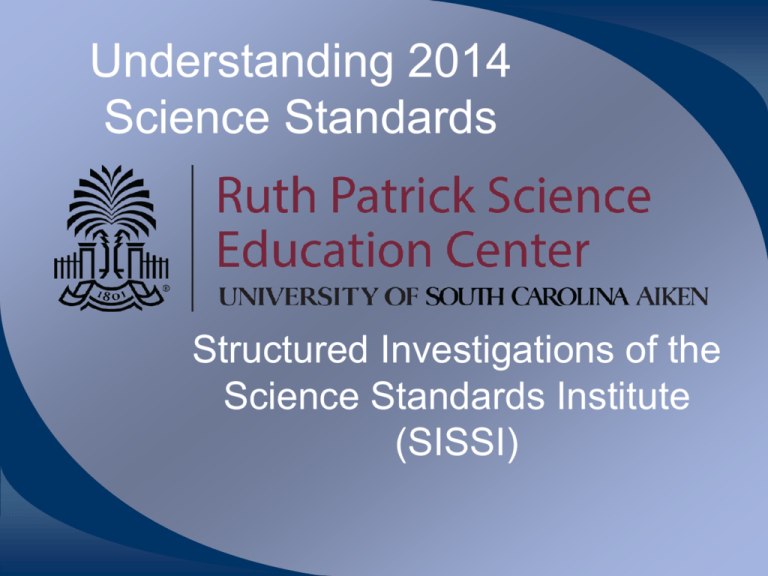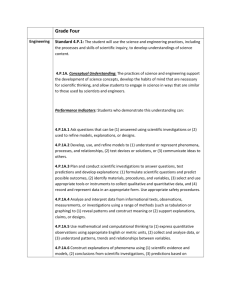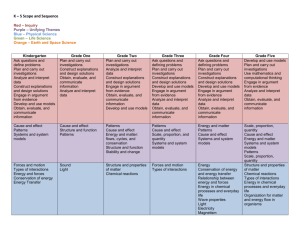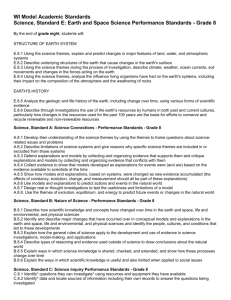Understanding the Science and Engineering Practices (SEPs)
advertisement

Understanding 2014 Science Standards Structured Investigations of the Science Standards Institute (SISSI) The Progression South Carolina Academic Standards and Performance Indicators for Science Framework for Science Ed The framework is designed to help realize a vision for education in the sciences and engineering in which students, over multiple years of school, actively engage in scientific and engineering practices and apply crosscutting concepts to deepen their understanding of the core ideas in these fields (A Framework, p. 10). Framework for Science Ed The framework and subsequent standards will not lead to improvements in K-12 science education unless the other components of the system - curriculum, instruction, professional development, and assessment - change so that they are aligned with the framework’s vision. (A Framework, p. 17). Principles of the Framework • • • • Children are born investigators Focusing on core ideas and practices Understanding develops over time Science and engineering require knowledge and practice • Connecting to students’ interests and experiences • Promoting equity Dimensions of the Framework • Science and Engineering Practices (SEPs) • CrossCutting Concepts (CCCs) • Disciplinary Core Ideas Science and Engineering Practices (SEPs) 1. Asking questions (for science) and defining problems (for engineering) 2. Developing and using models 3. Planning and carrying out investigations 4. Analyzing and interpreting data 5. Using mathematics and computational thinking 6. Constructing explanations (for science) and designing solutions (for engineering) 7. Engaging in argument from evidence 8. Obtaining, evaluating, and communicating information CrossCutting Concepts (CCCs) 1. Patterns 2. Cause and effect: Mechanism and explanation 3. Scale, proportion, and quantity 4. Systems and system models 5. Energy and matter: Flows, cycles, and conservation 6. Structure and function 7. Stability and change Disciplinary Core Ideas Physical Sciences • PS1: Matter and its interactions • PS2: Motion and stability: Forces and interactions • PS3: Energy • PS4: Waves and their applications in technologies for information transfer Disciplinary Core Ideas Life Sciences • LS1: From molecules to organisms: Structures and processes • LS2: Ecosystems: Interactions, energy, and dynamics • LS3: Heredity: Inheritance and variation of traits • LS4: Biological evolution: Unity and diversity Disciplinary Core Ideas Earth and Space Sciences • ESS1: Earth’s place in the universe • ESS2: Earth’s systems • ESS3: Earth and human activity Disciplinary Core Ideas Engineering, Technology, and Applications of Science • ETS1: Engineering design • ETS2: Links among engineering, technology, science, and society • Released April 10th, 2013 • 26-state consortium South Carolina Academic Standards and Performance Indicators for Science • State Board of Education Approval January 8, 2014 • Education Oversight Committee Approval February 10, 2014. • Begin Implementation 2014-15 – Testing on common standards • Full Implementation 2015-16 • Testing on new standards South Carolina CrossCutting Concepts (CCC) • Identical to A Framework for K-12 Science Education • Should become common and familiar • Have value to scientists and engineers • Identify universal properties and processes found. • Should not be taught in isolation Some important themes pervade science, mathematics, and technology and appear over and over again, whether we are looking at an ancient civilization, the human body, or a comet. They are ideas that transcend disciplinary boundaries and prove fruitful in explanation, in theory, in observation, and in design. —American Association for the Advancement of Science South Carolina Science and Engineering Practices (SEPs) 1. Ask questions and define problems Asking questions (for science) and defining problems (for engineering) 2. Develop and use models 3. Plan and conduct investigations 4. Analyze and interpret data 5. Use mathematical and computational thinking 6. Construct explanations and design solutions 7. Engage in scientific argument from evidence 8. Obtain, evaluate, and communicate information South Carolina Science and Engineering Practices (SEPs) • Part B • 4th Disciplinary Core Idea from Framework – Engineering, Technology, and Applications of Science SEPs Essential Questions • Why Science and Engineering Practices? • How do the practices of scientists compare with those of engineers? • How are the SEPs arranged in the 2014 Standards and Performance Indicators? • How are the SEPs developed through the grades from kindergarten to high school? SEPs Essential Question Why Science and Engineering Practices? What happened to Inquiry? Why practices ? • Practice refers to doing something repeatedly in order to become proficient • Working with core ideas and practices over multiple years supports learning • Science and engineering require both knowledge and practice • Scientific inquiry is one form of scientific practices. – So, the perspective in the Framework is not one of replacing inquiry; rather, expanding and enriching teaching and learning of science. Four proficiencies linking content and practices Students who are proficient in science: • Know, use, and interpret scientific explanations of the natural world; • Generate and evaluate scientific evidence and explanations; • Understand the nature and development of scientific knowledge; and • Participate productively in scientific practices and discourse. Duschl, Schweingruber, and Shouse. Taking Science to School. 2007. SEPs Essential Question How do the practices of scientists compare with those of engineers? In the K-12 context, • “Science” means the traditional natural sciences: physics, chemistry, biology, and Earth, space, and environmental science • “Engineering” means any engagement in a systematic practice of design to achieve solutions to particular human problems • “Technology” includes all types of human-made systems and processes (not just electronic) “Technologies result when engineers apply their understanding of the natural world and of human behavior to design ways to satisfy human needs and wants.” (NRC 2011, pp 1-3, 4) What are the eight SEPs? Ask questions and define problems Use mathematical and computational thinking Develop and use models Construct explanations and design solutions Plan and carry out investigations Engage in scientific argument Analyze and interpret data Obtain, evaluate, and communicate information 1. Ask Questions and Define Problems Science • Begins with a question about a phenomenon Engineering • Begins with a problem, need or desire 2. Develop and Use Models Science • Uses models to develop explanations Engineering • Uses models to analyze and test systems 3. Plan and Conduct Investigations Science • Uses investigations to gain data – Develop new theories – Test and revise existing theories Engineering • Uses investigations to gain data – Specify design parameters – Test designs 4. Analyze and Interpret Data Science • Analyzes and interprets data to derive meaning • Use a range of tools to identify features and patterns Engineering • Analyzes and interprets data to determine how well a design meets criteria • Use a range of tools to identify features and patterns 5. Use Mathematics and Computational Thinking Science • Represent physical variables • Enable predictions of physical systems Engineering • Integral part of design • Develop, test and improve designs 6. Construct Explanations and Design Solutions Science • Understanding our world • Construct theories to explain phenomenon Engineering • Solving problems in our world • Construct designs to solve problems • Based on scientific knowledge 7. Engage in Argument from Evidence Science • Identifying strengths and weaknesses in reasoning • Examine understanding in light of evidence • Collaborate with peers to search for explanations Engineering • Finding the best possible solution • Compare alternatives • Collaborate with peers to select most promising solution 8. Obtain, Evaluate, and Communicate Information Science • Derive meaning from scientific sources • Evaluate scientific validity • Communicate findings Engineering • Derive meaning from the work of others • Compare alternatives • Communicate solutions SEPs Essential Question How are the SEPs arranged in the 2014 Standards and Performance Indicators? Structure of the 2014 Standards • Grade Level (High School Course) Overview • SEPs and Content/Core Area – Standard – Conceptual Understanding – Performance Indicators • a specific science and engineering practice • content knowledge and skills Deconstruct Performance Indicators (PI) • Individually – Use two PIs (different areas) – Identify the SEP – Identify the content – Identify CCCs • Small Group – Individuals share 1 deconstructed PI • Large Group – Small Groups share 1 PI SEPs Essential Question How are the SEPs developed through the grades from kindergarten to high school? Scientific Inquiry vs SEPs 2014 Science and Engineering Practices 2005 Scientific Inquiry • • • • • • • • Observe Infer Predict Classify Generate questions Use scientific tools Plan investigations Organize and interpret data • • • • • Ask questions and define problems Develop and use models Plan and conduct investigations Analyze and interpret data Use mathematical and computational thinking • Construct explanations and design solutions • Engage in scientific argument using evidence • Obtain, evaluate and communicate information K-2 Ask and answer questions about the natural world using explorations, observations, or structured investigations. 3-4 Ask questions that can be (1) answered using scientific investigations or (2) used to refine models, explanations, or designs. 5 Ask questions and define problems 6-8 B, C, P, E Ask questions to (1) generate hypotheses for scientific investigations or (2) refine models, explanations, or designs. Ask questions to (1) generate hypotheses for scientific investigations, (2) refine models, explanations, or designs, or (3) extend the results of investigations or challenge claims. Ask questions to (1) generate hypotheses for scientific investigations, (2) refine models, explanations, or designs, or (3) extend the results of investigations or challenge scientific arguments or claims. Develop and use models Develop and use models to (1) understand or represent phenomena, processes, and K-12 relationships, (2) test devices or solutions, or (3) communicate ideas to others. structured investigations Plan and conduct investigations K With teacher guidance, conduct to answer scientific questions, test predictions and develop explanations: (1) predict possible outcomes, (2) identify materials and follow procedures, (3) use appropriate tools or instruments to make nonstandard qualitative observations and take measurements, and (4) record and represent data in an appropriate form. Use appropriate safety procedures. 1-2 With teacher guidance, conduct structured investigations to answer scientific questions, test predictions and develop explanations: (1) predict possible outcomes, (2) identify materials and follow procedures, (3) use appropriate tools or instruments to collect qualitative and quantitative data, and (4) record and represent data in an appropriate form. Use appropriate safety procedures. Plan and conduct scientific investigations to answer questions, test predictions and develop explanations: (1) formulate scientific questions and predict possible outcomes, (2) identify 3-4 variables materials, procedures, and , (3) select and use appropriate tools or instruments to collect qualitative and quantitative data, and (4) record and represent data in an appropriate form. Use appropriate safety procedures. controlled 5-8 Plan and conduct scientific investigations to answer questions, test hypotheses, and develop explanations: (1) formulate scientific questions and testable hypotheses, (2) identify materials, procedures, and variables, (3) select and use appropriate tools or instruments to collect qualitative and quantitative data, and (4) record and represent data in an appropriate form. Use appropriate safety procedures. Plan and conduct controlled scientific investigations to answer questions, test hypotheses, and develop explanations: (1) formulate scientific questions and testable hypotheses based on scientific information, (2) identify materials, procedures, B, C, P, E credible and variables, (3) use appropriate laboratory equipment, technology, and techniques to collect qualitative and quantitative data, and (4) record and represent data in an appropriate form. Use appropriate safety procedures. Analyze and interpret data K-3 Analyze and interpret data from observations, measurements, or investigations to understand patterns and meanings. Analyze and interpret data from informational texts, observations, measurements, or investigations using a range of 4 methods (such as tabulation or graphing) to (1) reveal patterns and construct meaning or (2) support explanations, claims, or designs. Analyze and interpret data from informational texts, observations, measurements, or investigations using a range of methods (such as tabulation or graphing) to (1) reveal patterns and construct 5 meaning or (2) support hypotheses, explanations, claims, or designs. Analyze and interpret data from informational texts, observations, measurements, or investigations using a range of methods 6-8 (such as tabulation, graphing, or statistical analysis) to (1) reveal patterns and construct meaning or (2) support hypotheses, explanations, claims, or designs. Analyze and interpret data from informational texts and data collected from investigations using a range of methods (such as B, C, P, tabulation, graphing, or statistical analysis) to (1) reveal patterns and construct meaning, (2) support or refute hypotheses, E explanations, claims, or designs, or (3) evaluate the strength of conclusions. Use mathematical and computational thinking K 1 2-3 4 5 6-8 B, C, P, E Use mathematical thinking to (1) recognize and express quantitative observations, (2) collect and analyze data, or (3) understand patterns and relationships. Use mathematical and computational thinking to (1) recognize and express quantitative observations, (2) collect and analyze data, or (3) understand patterns and relationships. Use mathematical and computational thinking to (1) express quantitative observations using appropriate English or metric units, (2) collect and analyze data, or (3) understand patterns, trends and relationships. Use mathematical and computational thinking to (1) express quantitative observations using appropriate English or metric units, (2) collect and analyze data, or (3) understand patterns, trends and relationships between variables. Use mathematical and computational thinking to (1) express quantitative observations using appropriate metric units, (2) collect and analyze data, or (3) understand patterns, trends and relationships between variables. Use mathematical and computational thinking to (1) use and manipulate appropriate metric units, (2) collect and analyze data, (3) express relationships between variables for models and investigations, or (4) use grade-level appropriate statistics to analyze data. Construct explanations and design solutions K Construct explanations of phenomena using (1) studentgenerated observations and measurements, (2) results of investigations, or (3) data communicated in graphs, tables, or diagrams. 1-2 Construct explanations of phenomena using (1) studentgenerated observations and measurements, (2) results of scientific investigations, or (3) data communicated in graphs, tables, or diagrams. 3-5 Construct explanations of phenomena using (1) scientific evidence and models, (2) conclusions from scientific investigations, (3) predictions based on observations and measurements, or (4) data communicated in graphs, tables, or diagrams. Construct explanations of phenomena using (1) primary 6-8 or secondary scientific evidence and models, (2) conclusions from scientific investigations, (3) predictions B, C, P, E based on observations and measurements, or (4) data communicated in graphs, tables, or diagrams. Engage in scientific argument from evidence K 1-2 3-5 6-8 B, C, P, E Construct scientific arguments to support explanations using evidence from observations or data collected. Construct scientific arguments to support claims or explanations using evidence from observations or data collected. Construct scientific arguments to support claims, explanations, or designs using evidence from observations, data, or informational texts. Construct and analyze scientific arguments to support claims, explanations, or designs using evidence from observations, data, or informational texts. Construct and analyze scientific arguments to support claims, explanations, or designs using evidence and valid reasoning from observations, data, or informational texts. Obtain, evaluate, and communicate information K-2 Obtain and evaluate informational texts, observations, data collected, or discussions to (1) generate and answer questions about the natural world, (2) understand phenomena, (3) develop models, or (4) support explanations. Communicate observations and explanations using oral and written language. 3-4 Obtain and evaluate informational texts, observations, data collected, or discussions to (1) generate and answer questions, (2) understand phenomena, (3) develop models, or (4) support explanations, claims, or designs. Communicate observations and explanations using the conventions and expectations of oral and written language. Obtain and evaluate informational texts, observations, data collected, or discussions to (1) generate and answer questions, (2) understand phenomena, (3) develop models, or (4) support hypotheses, 5 explanations, claims, or designs. Communicate observations and explanations using the conventions and expectations of oral and written language. Obtain and evaluate scientific information to (1) answer questions, (2) explain or describe phenomena, (3) develop models, (4) evaluate 6-8 hypotheses, explanations, claims, or designs or (5) identify and/or fill gaps in knowledge. Communicate using the B, C, P, conventions and expectations of scientific writing or oral presentations by (1) evaluating grade-appropriate primary or E secondary scientific literature, or (2) reporting the results of student experimental investigations. Engineering Design K-2 3-5 6-8 Construct devices or design solutions to solve specific problems or needs: (1) ask questions to identify problems or needs, (2) ask questions about the criteria and constraints of the devices or solutions, (3) generate and communicate ideas for possible devices or solutions, (4) build and test devices or solutions, (5) determine if the devices or solutions solved the problem, and (6) communicate the results. Construct devices or design solutions to solve specific problems or needs: (1) ask questions to identify problems or needs, (2) ask questions about the criteria and constraints of the devices or solutions, (3) generate and communicate ideas for possible devices or solutions, (4) build and test devices or solutions, (5) determine if the devices or solutions solved the problem and refine the design if needed, and (6) communicate the results. devices or design solutions using scientific knowledge to solve specific problems or needs: (1) ask questions B, C, P, to identify problems or needs, (2) ask questions about the criteria E and constraints of the device or solutions, (3) generate and communicate ideas for possible devices or solutions, (4) build and test devices or solutions, (5) determine if the devices or solutions solved the problem and refine the design if needed, and (6) communicate the results. Construct SEPs – Complementing Goals • Science and engineering practices are complementary; should be mutually reinforcing • Shift to practices includes scientific inquiry and reinforces the need to involve students actively in learning • Abilities and understandings of the SEPs for students should progressively get deeper and broader across the K-12 continuum • SEPs should be taught as both learning outcomes and instructional strategies • When students engage in scientific practices, activities become the basis for learning about experiments, data and evidence, social discourse, models and tools, and mathematics and for developing the ability to evaluate knowledge claims, conduct empirical investigations, and develop explanations. • Bybee, Roger W. “Scientific and Engineering Practices in K-12 Classrooms.” Resources • Bybee, Roger W. “Scientific and Engineering Practices in K-12 Classrooms.” Published in the December 2011 issues of NSTA Journals. • Duschl, R., H. Schweingruber, H., and A. Shouse. (Eds.). 2007. Taking science to school: Learning and teaching science in grades K-8. Washington, DC: National Academies Press. • Michaels, S., A. Shouse, and H. Schweingruber. 2008. Read, Set, Science!: Putting research to work in K-8 science classrooms. Washington, DC: National Academies Press. • National Research Council (NRC). 2011. A framework for K-12 science education: Practices, crosscutting concepts, and core ideas. Washington, DC: National Academies Press. • Sneider, Carl. “Core Ideas of Engineering and Technology.” Published in the January 2012 issues of NSTA Journals. Some content from: (SC)2 Professional Development Day February 21, 2014 by Dana M Hutto Education Consultant danahutto@bellsouth.net







